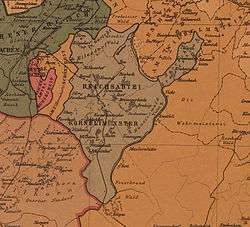Kornelimünster Abbey
Kornelimünster Abbey (German: Benediktinerabtei Kornelimünster), also known as Abbey of the Abbot Saint Benedict of Aniane and Pope Cornelius, is a Benedictine monastery that has been integrated since 1972. The abbey is located in Aachen (in the district of Kornelimünster/Walheim) in North Rhine-Westphalia in Germany.
Imperial Abbey of Kornelimünster Reichsabtei Kornelimünster | |||||||||
|---|---|---|---|---|---|---|---|---|---|
| 9th century – 1802 | |||||||||
 Coat of arms
| |||||||||
 Kornelimünster in 1789 | |||||||||
| Status | Imperial Abbey | ||||||||
| Capital | Kornelimünster Abbey | ||||||||
| Government | Elective principality | ||||||||
| Historical era | Middle Ages | ||||||||
• Abbey founded | 814 | ||||||||
• Gained Reichsfreiheit | mid-9th century the 9th century | ||||||||
875 | |||||||||
• Joined Lower Rhenish– Westphalian Circle | 1500 | ||||||||
| 1802 | |||||||||
| June 9, 1815 | |||||||||
| |||||||||

History
The monastery was founded in 814 on the river Inde by Benedict of Aniane, an adviser to Emperor Louis the Pious (successor to Charlemagne). The monastery was at first known as the "Monastery of the Redeemer on the Inde".[1] In the mid-9th century, the monastery became an Imperial abbey ("Reichsunmittelbar") and received large endowments of land, as well as Biblical or Saviour's relics: a loincloth, a sudarium and two shroud-like cloths.[2]
In 875, one of the shrouds was exchanged for a relic of the head of the martyred Pope Cornelius (died in 253), after which the abbey was known as Sancti Cornelii ad Indam, and later as Kornelimünster. (The full official title of the present monastery is the Abbey of the Abbot Saint Benedict of Aniane and Pope Cornelius).[2]
In the 12th century, a Priest of Aachen composed the famous Tafelgüterverzeichnis, a registry of royal estates and what they owed the king's court. It is one of the earliest pieces of evidence for the extent of the German royal fisc.
In 1500, the Imperial abbey (Reichsabtei) of Kornelimünster became part of the Lower Rhenish–Westphalian Circle.
In 1802, the territory of Kornelimünster came under French rule, and the abbey was dissolved in the secularisation.[3] The abbey church became the parish church, and the remaining abbey buildings became property of the Bundesland of North Rhine-Westphalia. Kornelimünster came under the Mairie system in the Kanton Burtscheid. In 1815, Kornelimünster became part of the Kingdom of Prussia and of the district (Landkreis) of Aachen.
Second foundation
The monastery was re-founded by the Benedictines in 1906 at a different location in the western part of Kornelimünster and is still in operation as a member of the Subiaco Cassinese Congregation. It is an extra-provincial monastery, subject directly to the Abbot President of the Congregation. As of 2009, there were nine monks at Kornelimünster.
References
- Ardo Smeragdus. Vita sancti Benedicti Anianensis et Indensis abbatis
- Górny, Grzegorz. "The Aachen Relics", Witnesses to Mystery: Investigations into Christ's Relics, Ignatius Press, 2013, ISBN 9781586178444
- Paul Fabianek, Folgen der Säkularisierung für die Klöster im Rheinland – Am Beispiel der Klöster Schwarzenbroich und Kornelimünster, 2012, Verlag BoD, ISBN 978-3-8482-1795-3
Further reading
- Fabianek, Paul (2012). Folgen der Säkularisierung für die Klöster im Rheinland: Am Beispiel der Klöster Schwarzenbroich und Kornelimünster. BoD – Books on Demand. ISBN 978-3-8482-1795-3.
External links
![]()
- Kornelimünster Abbey official website (in German)
- History of the Reichsabtei Kornelimünster with map, 1789 (in German)
- Monumente-Online:Aachen - Notes on the Benedictine Abbey of Kornelimünster (in German)

